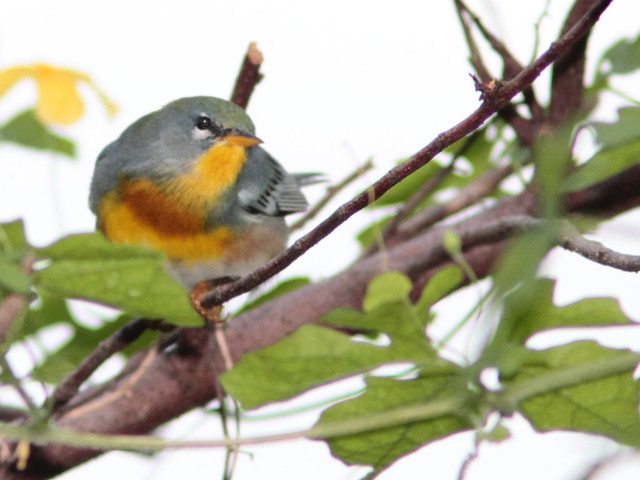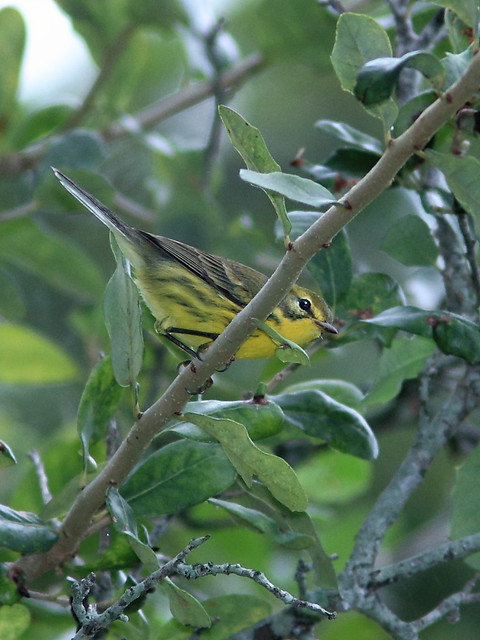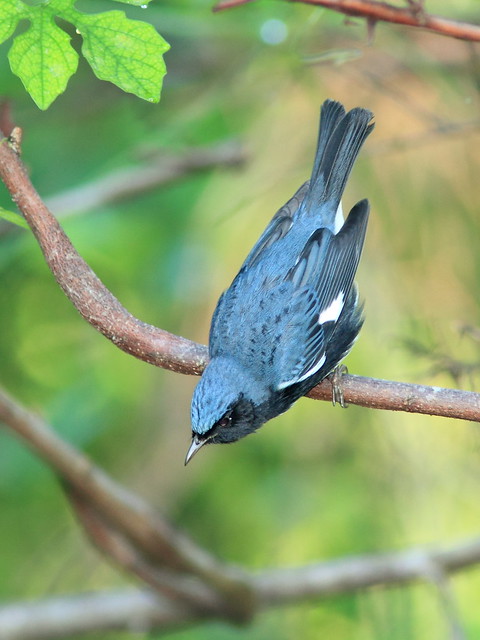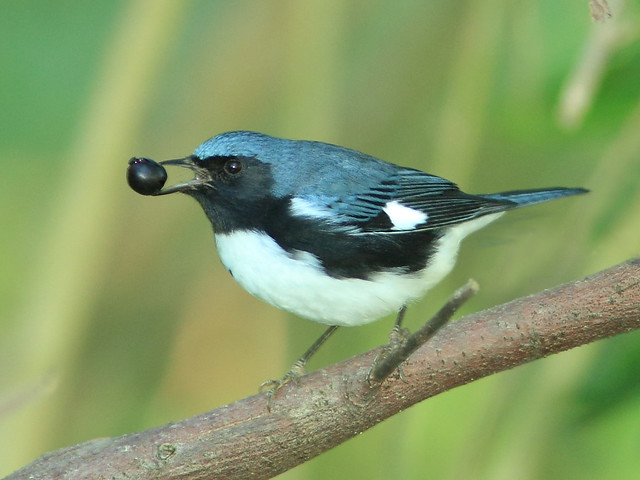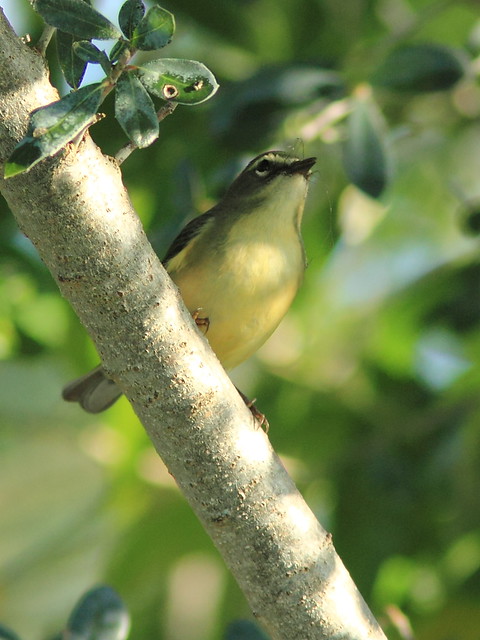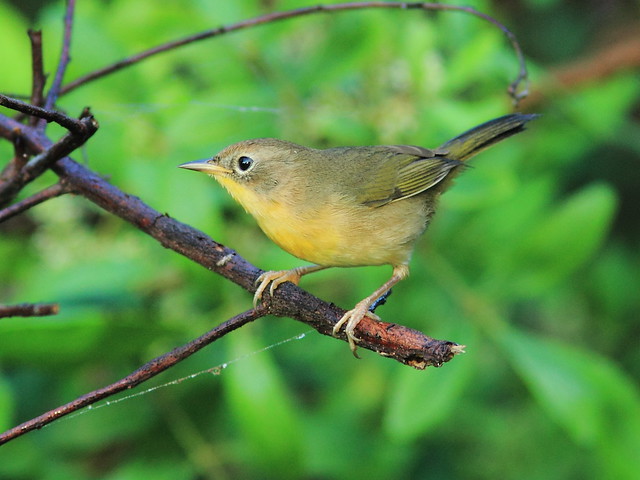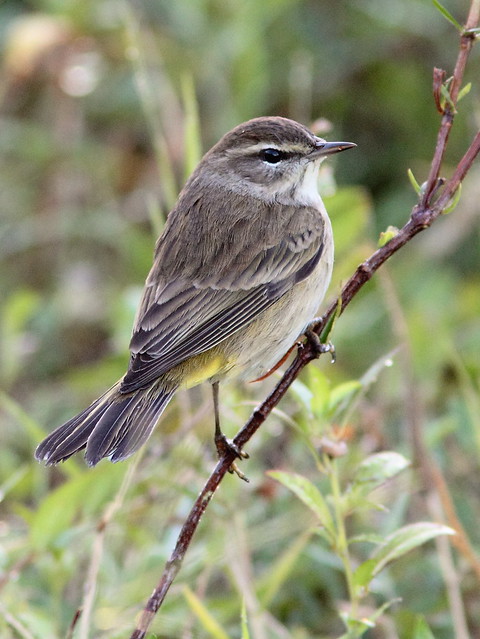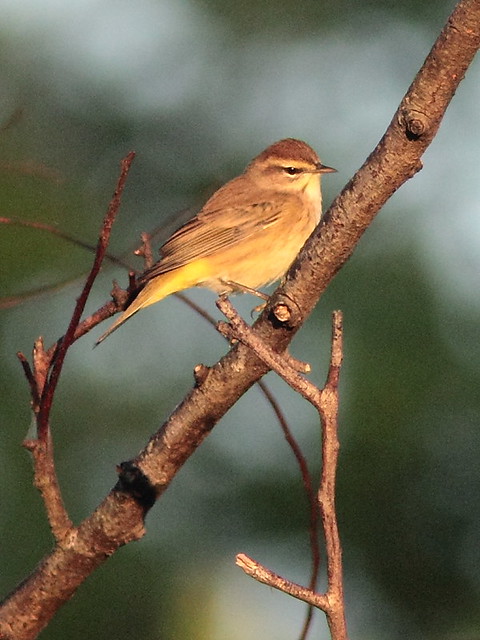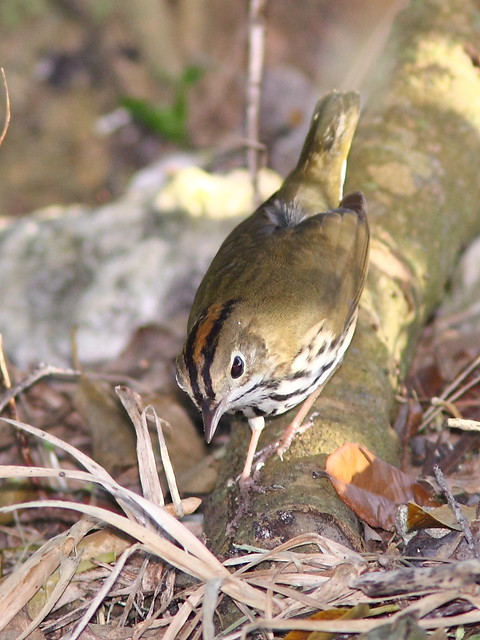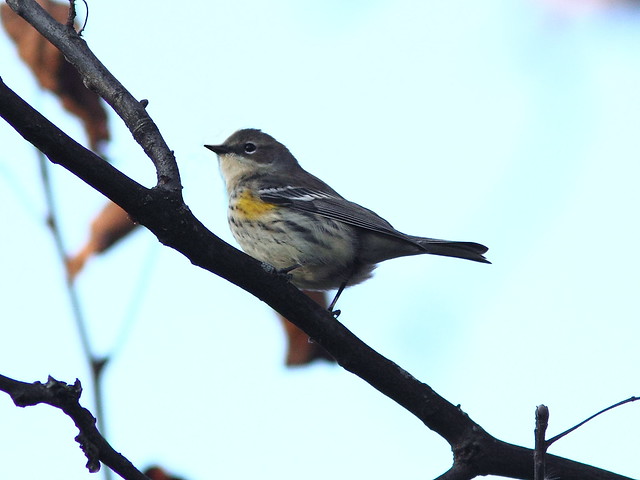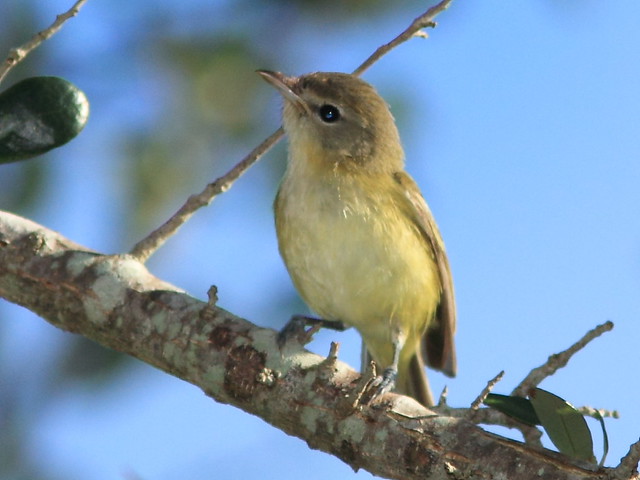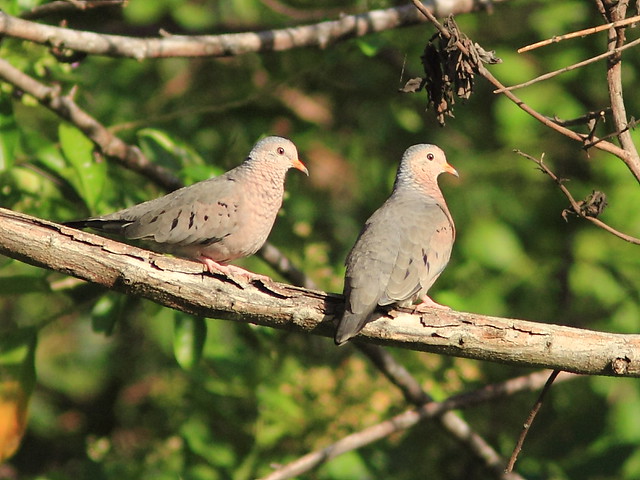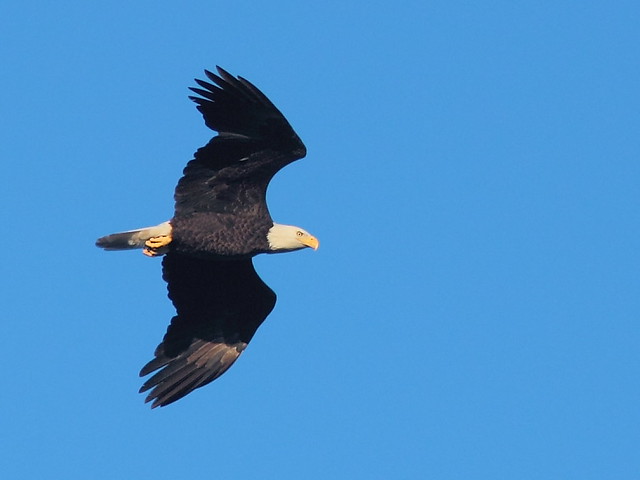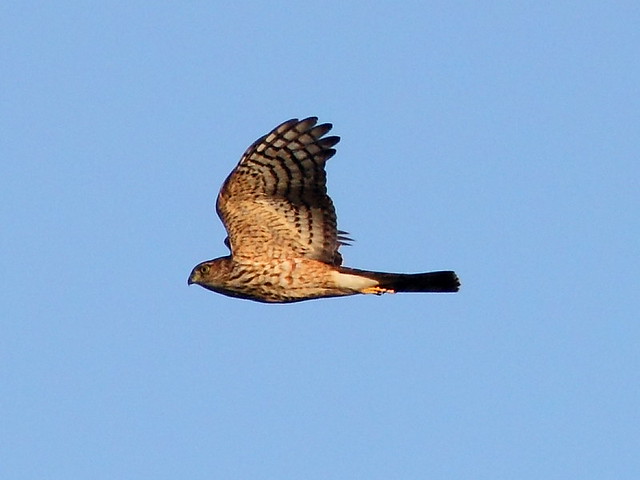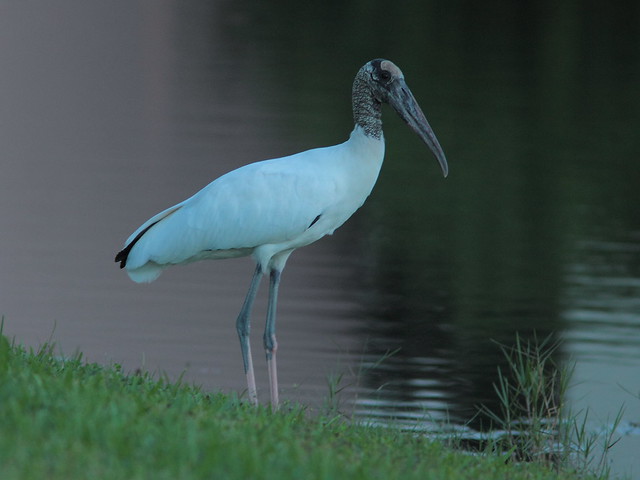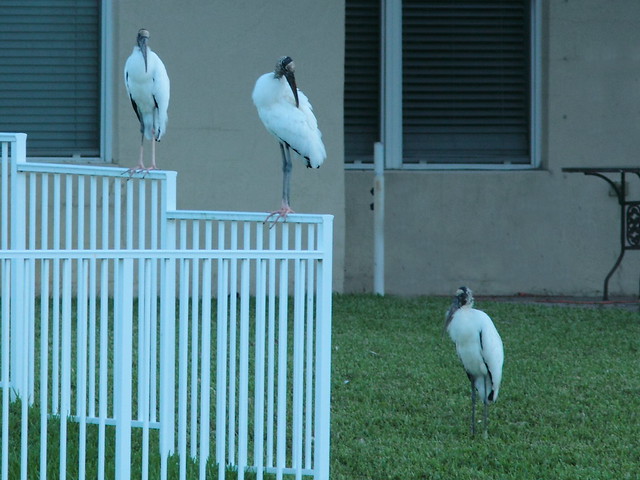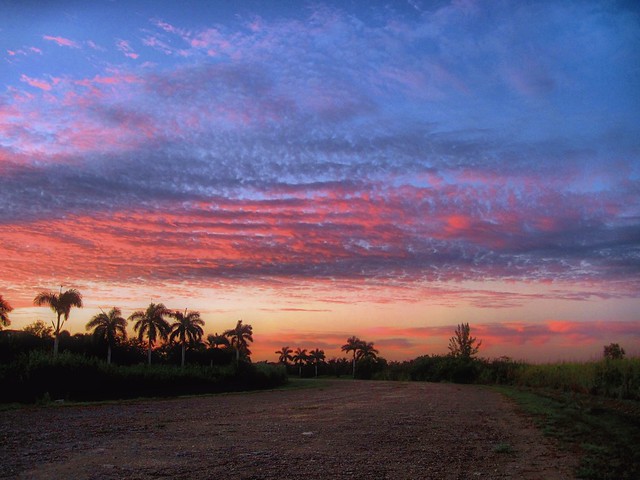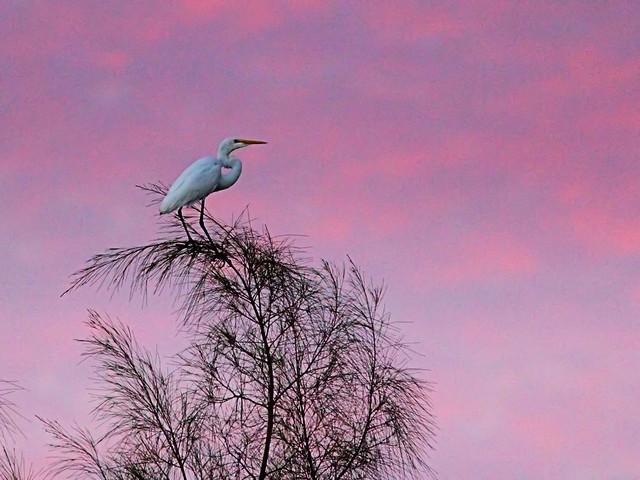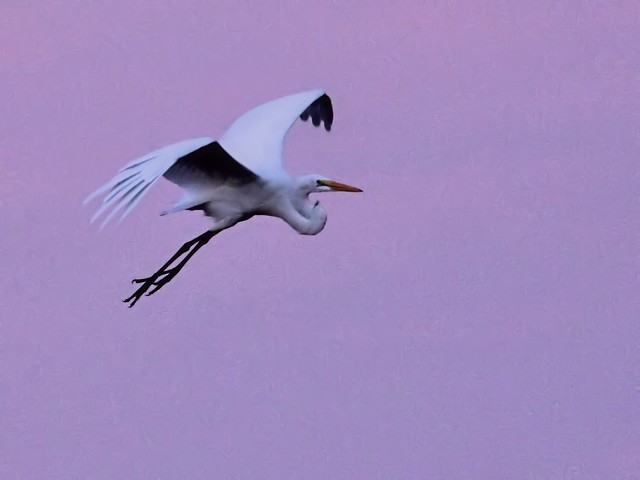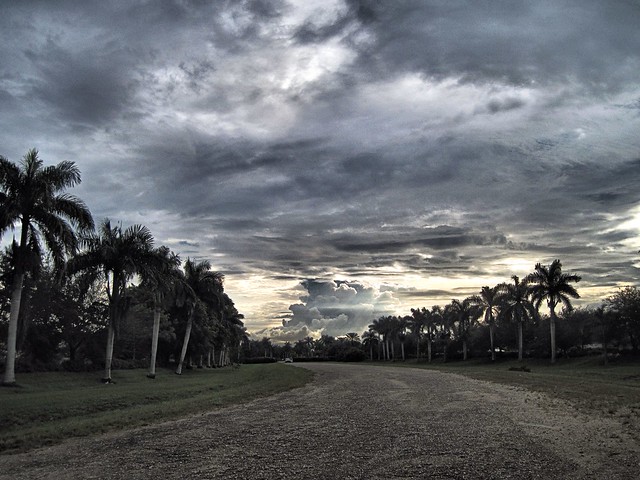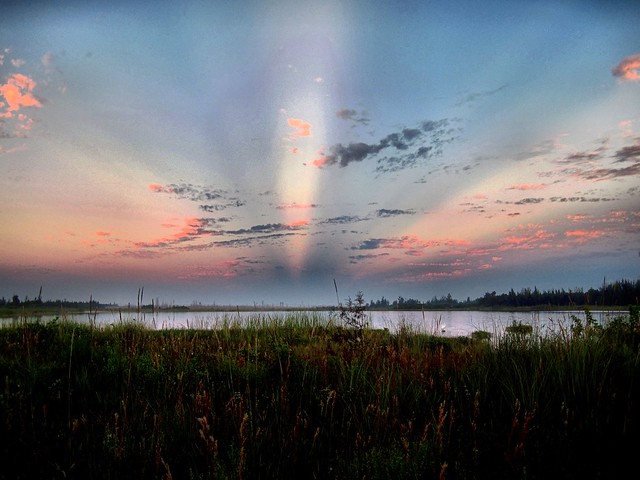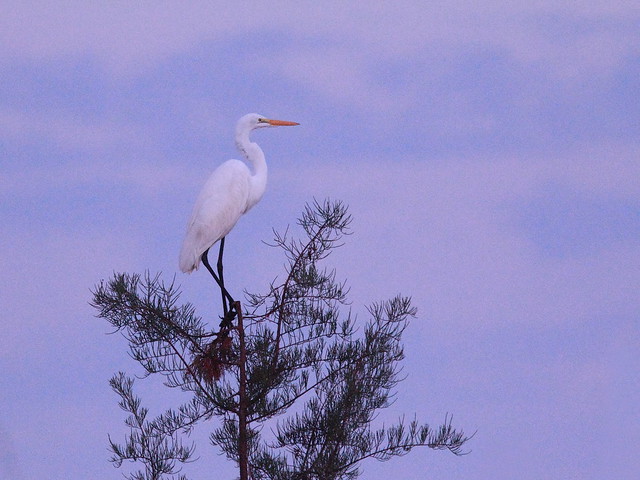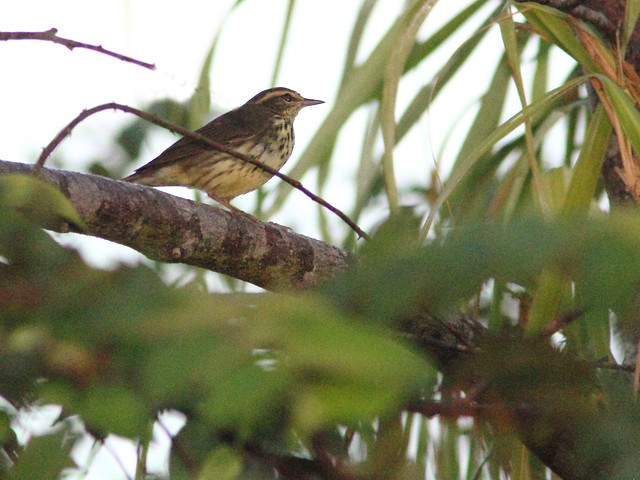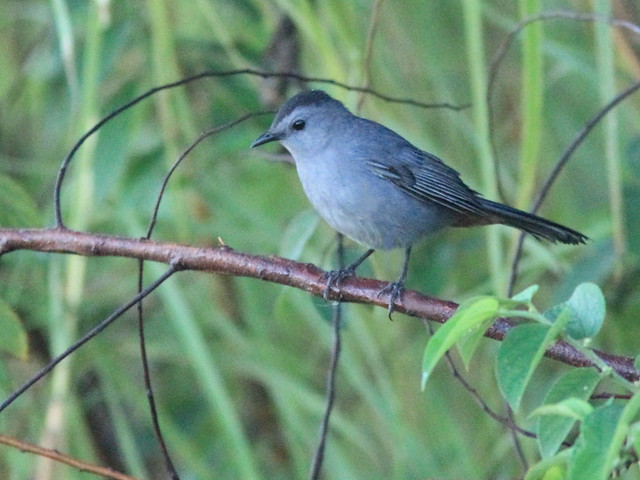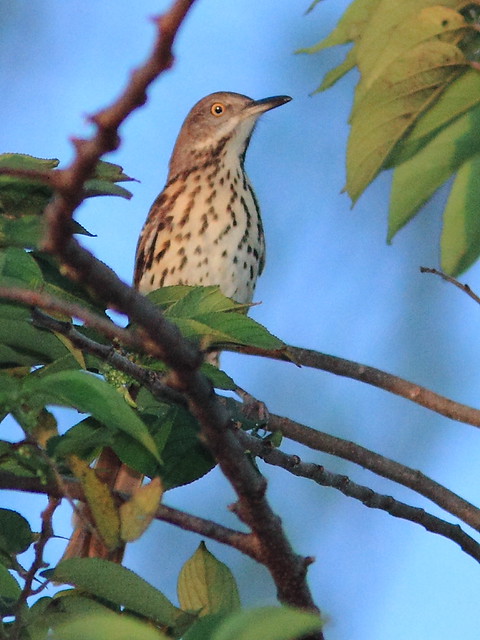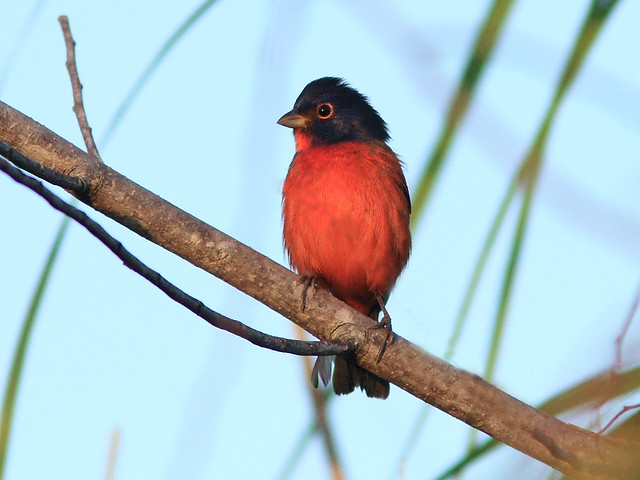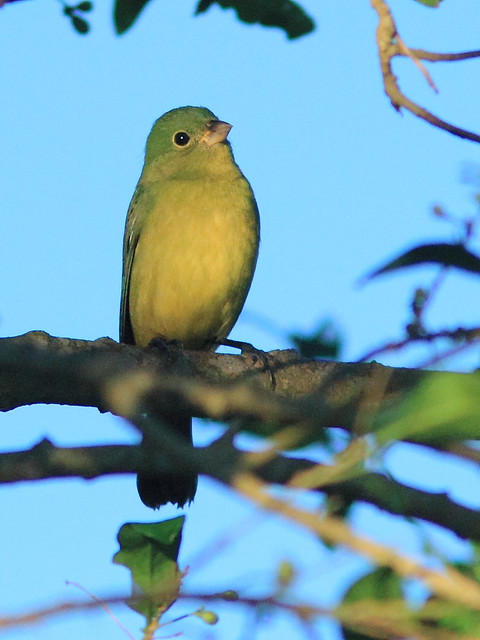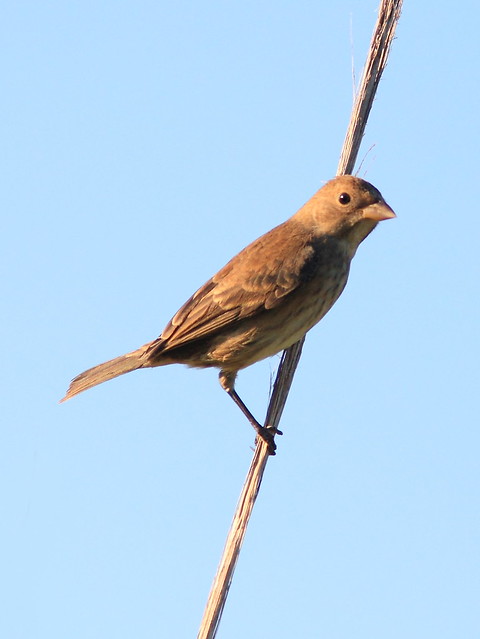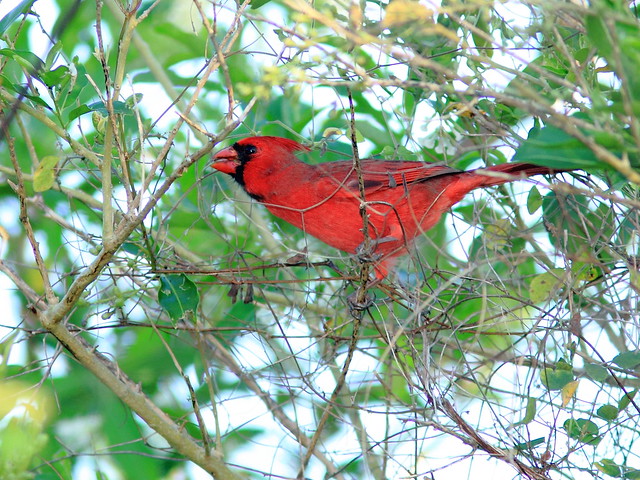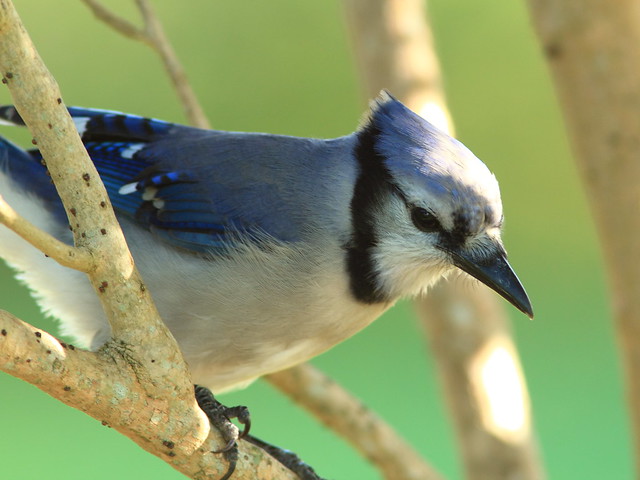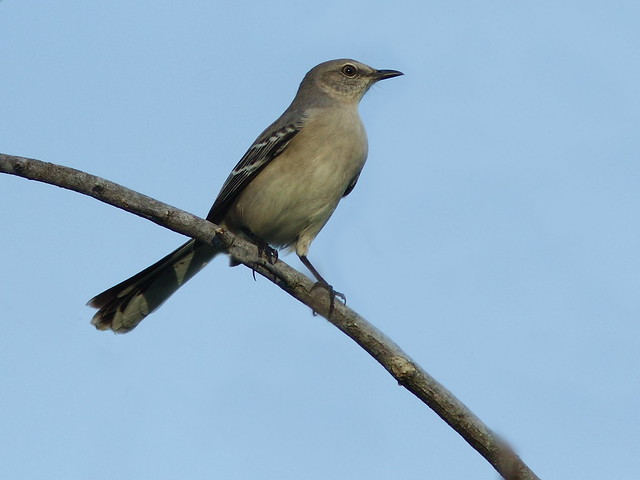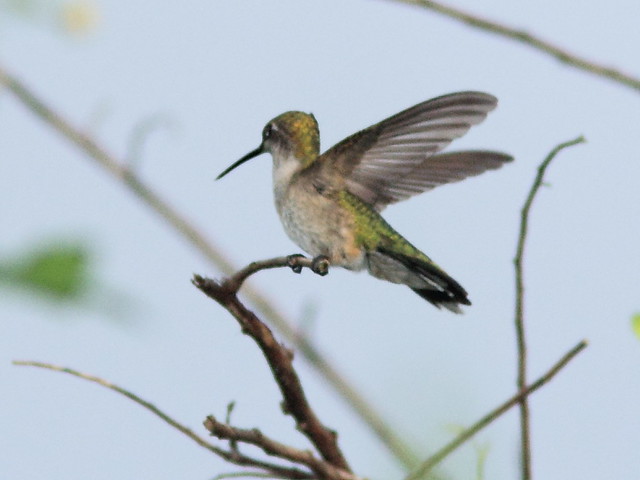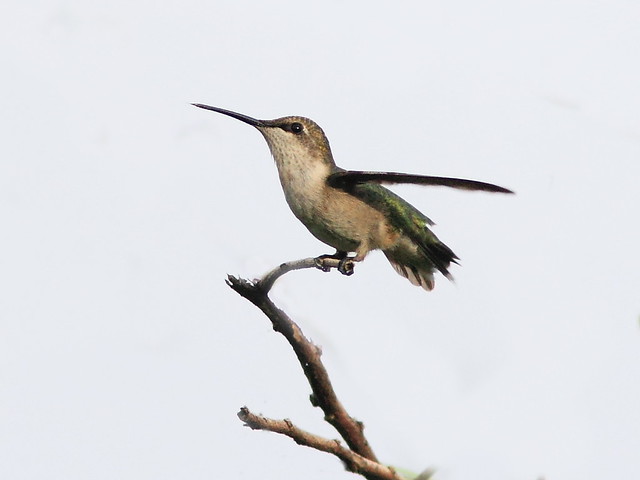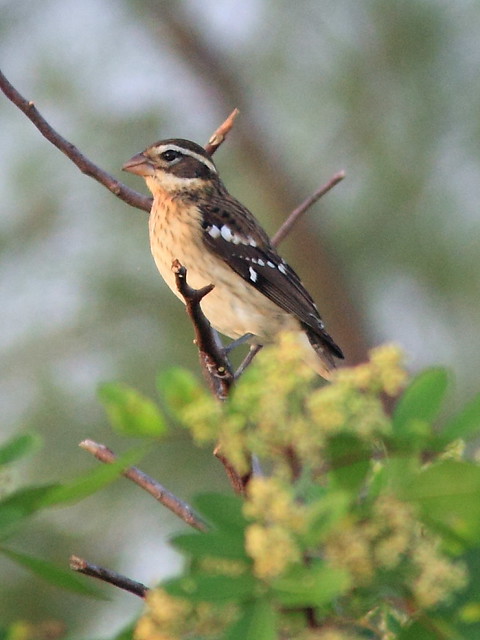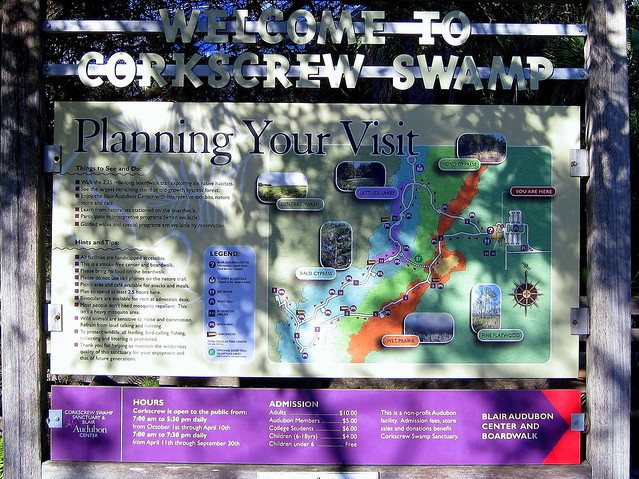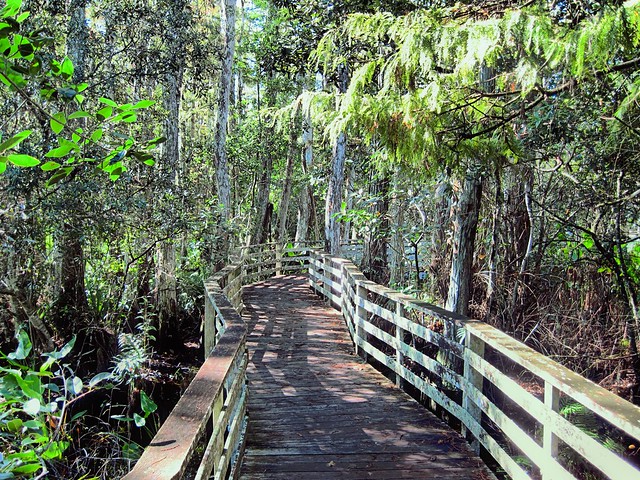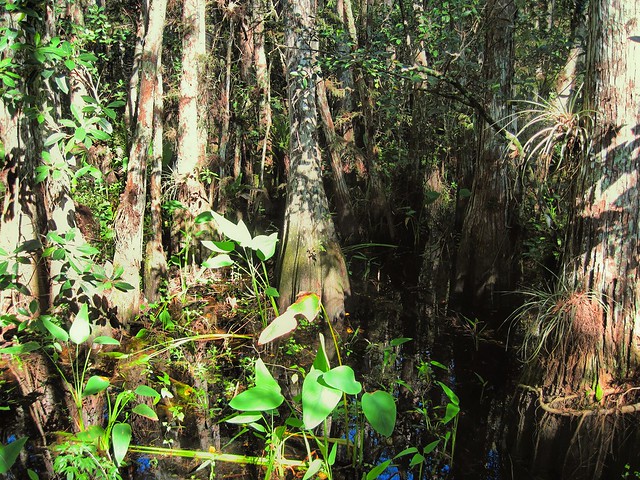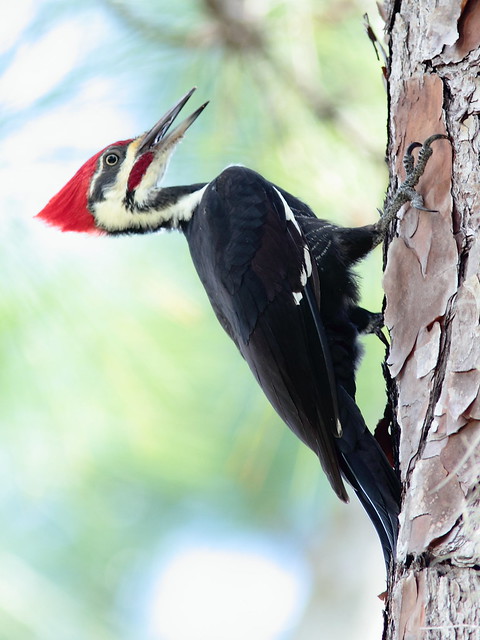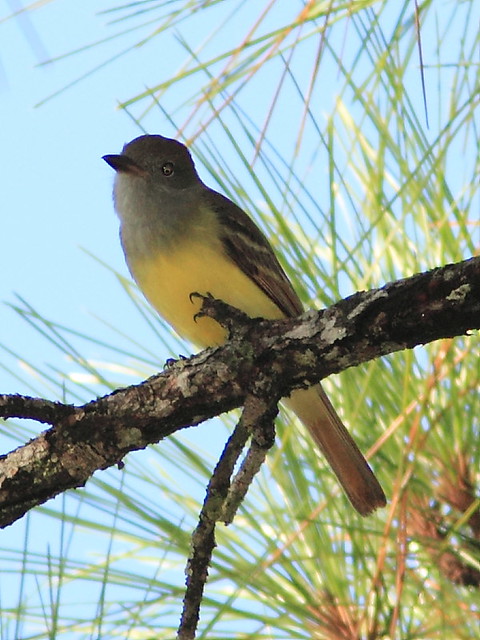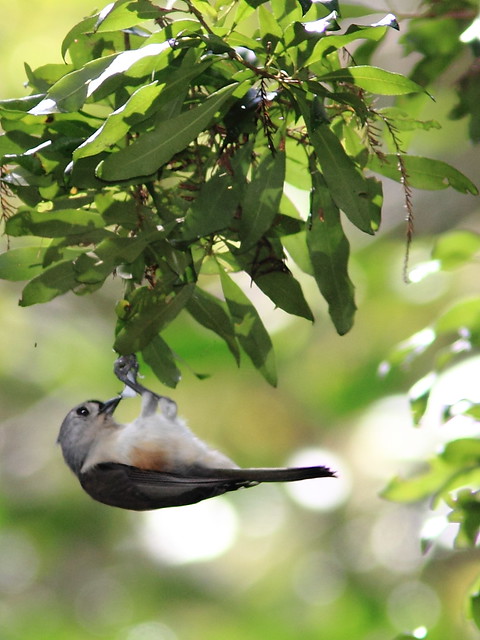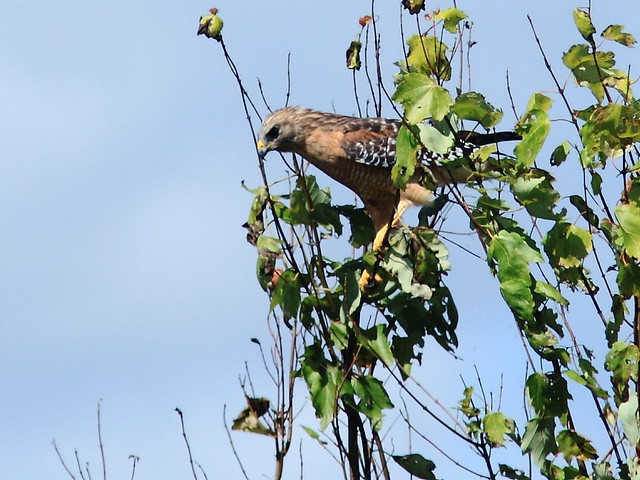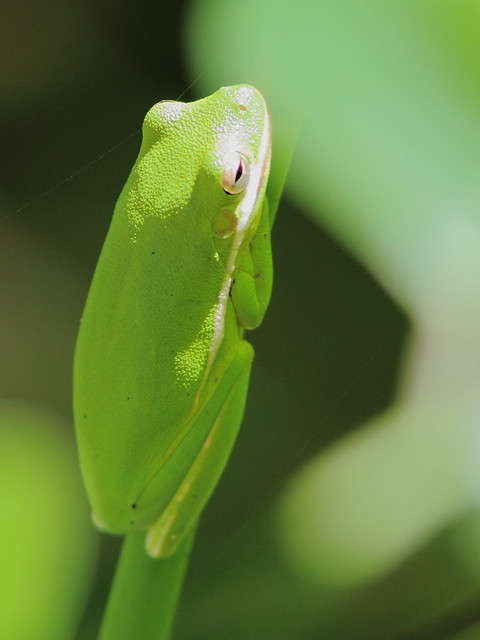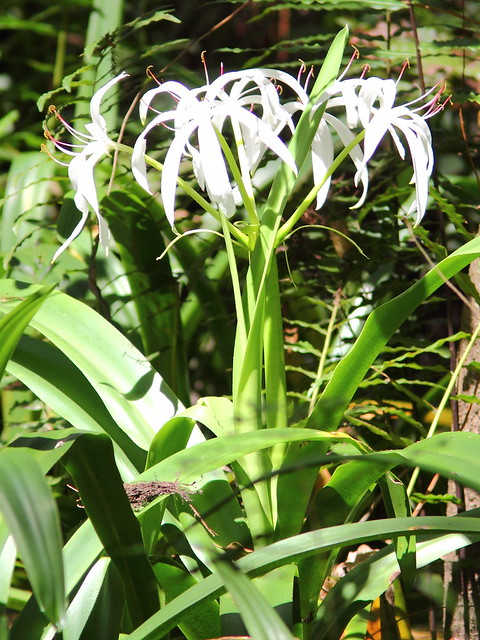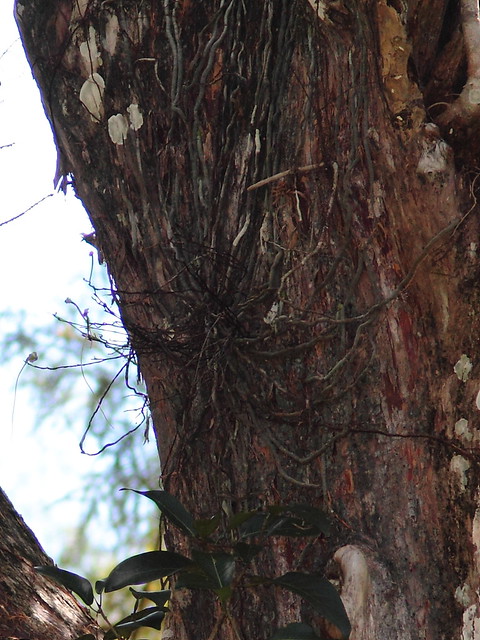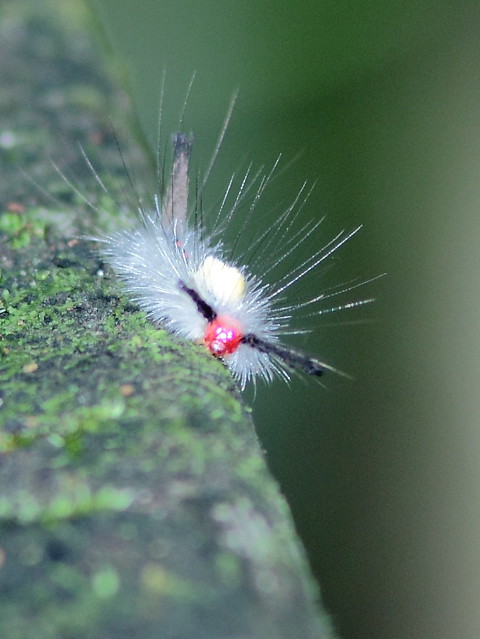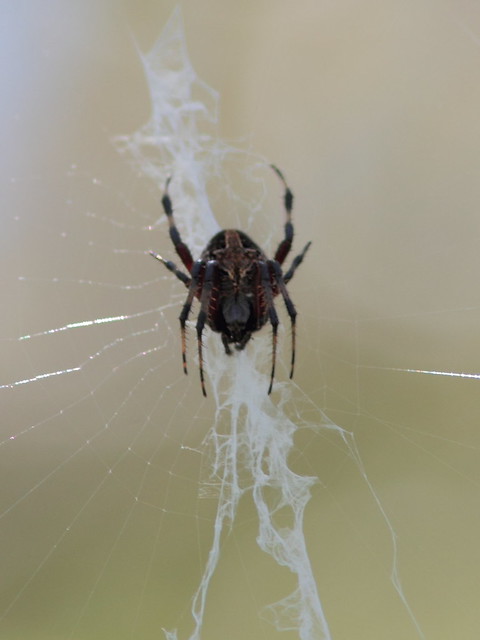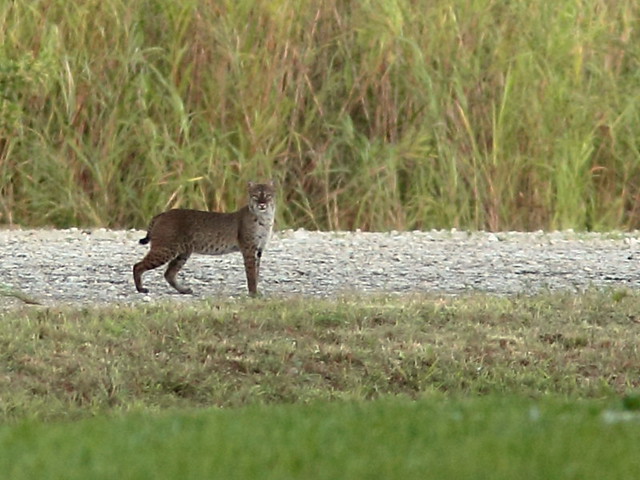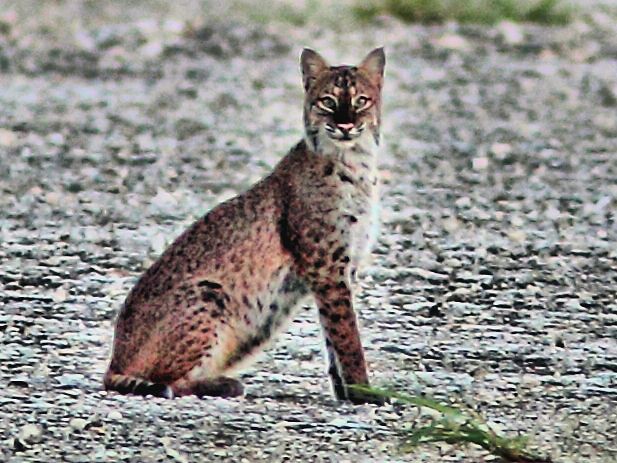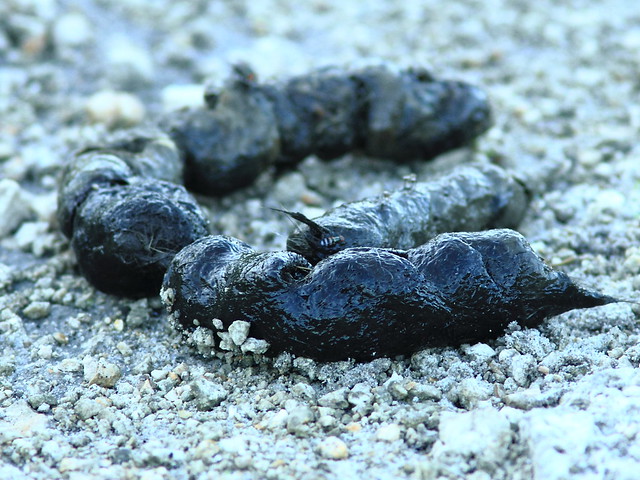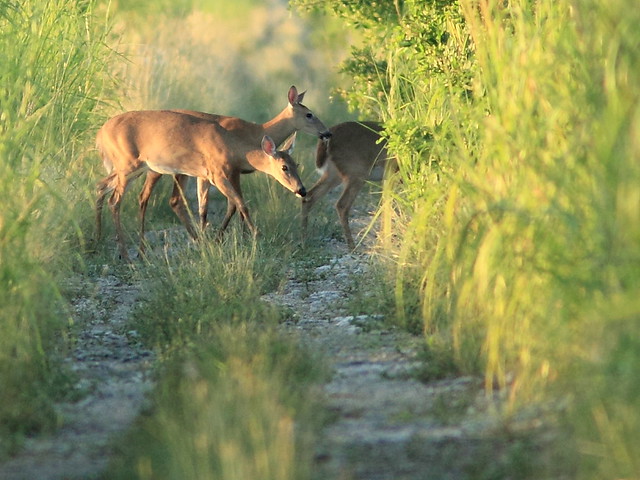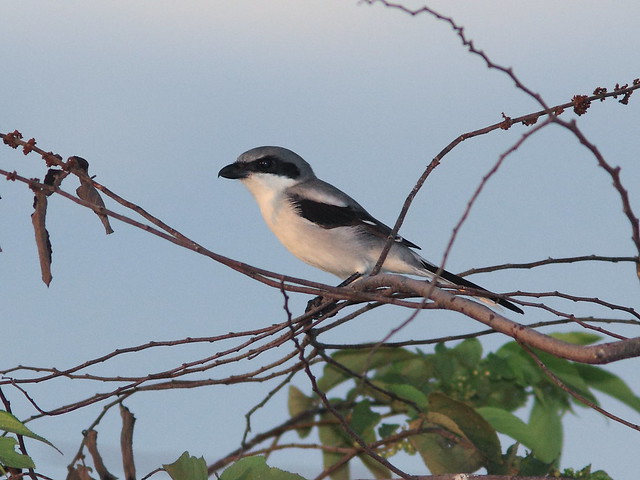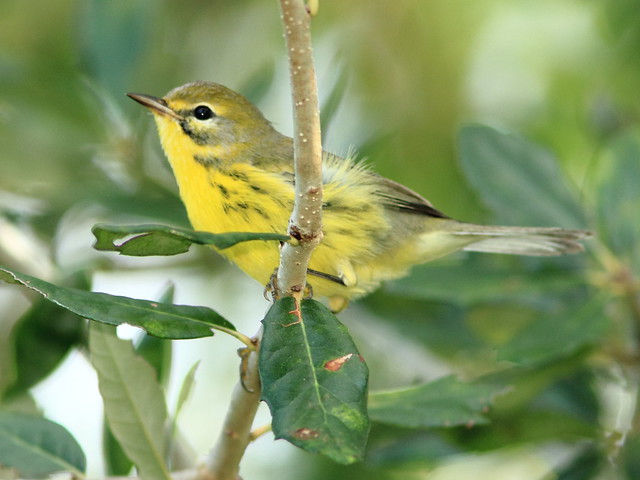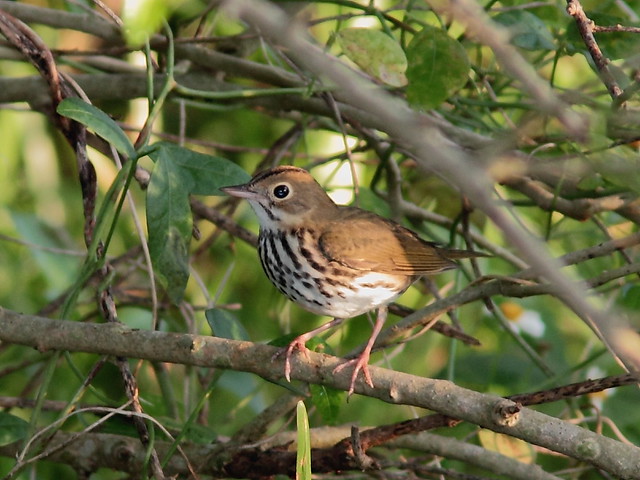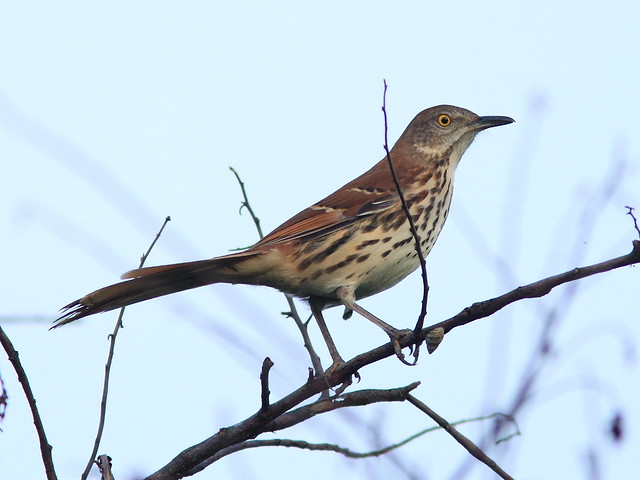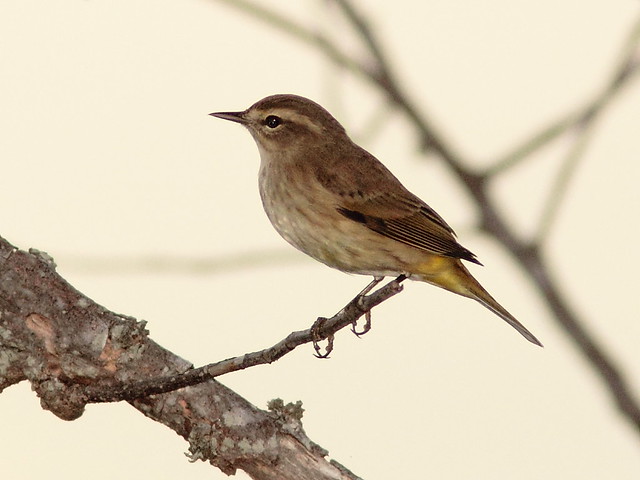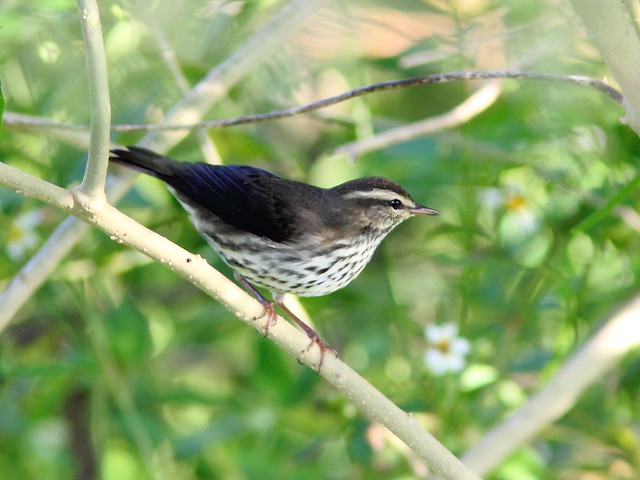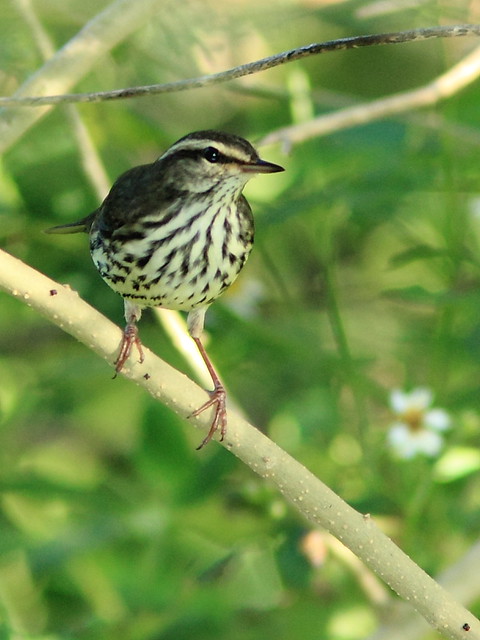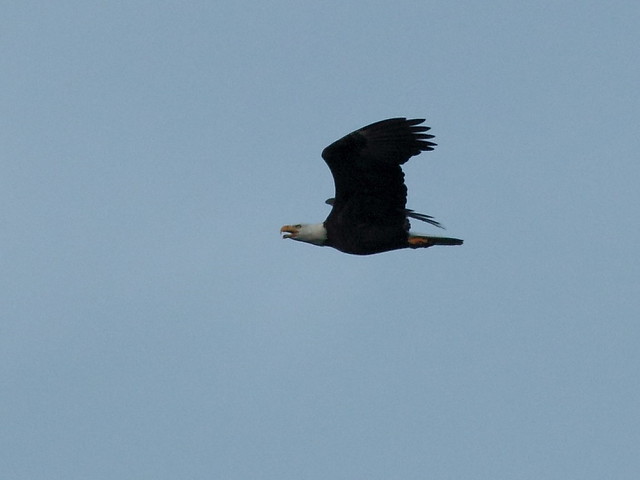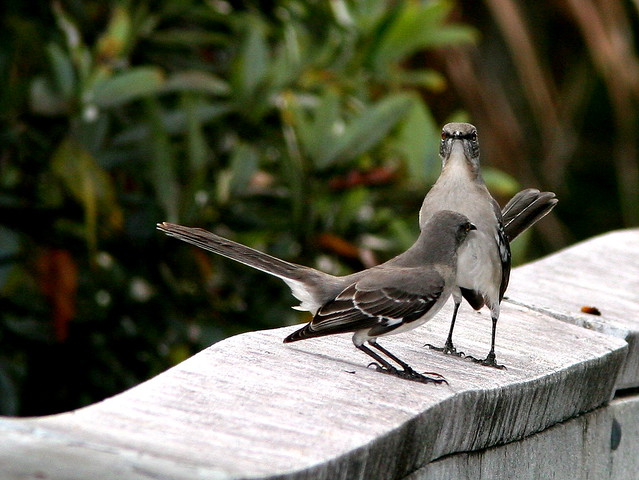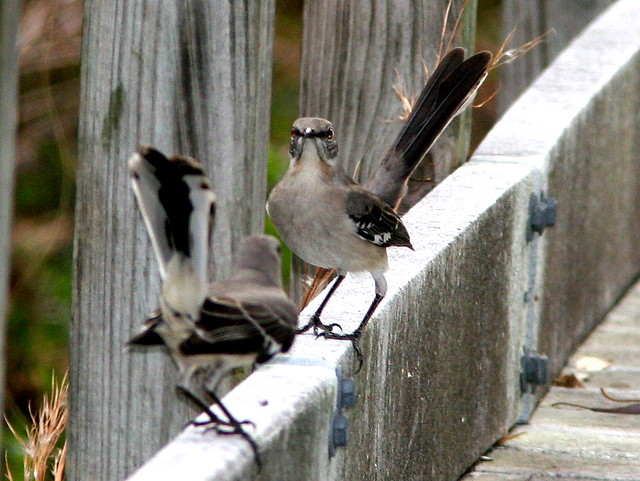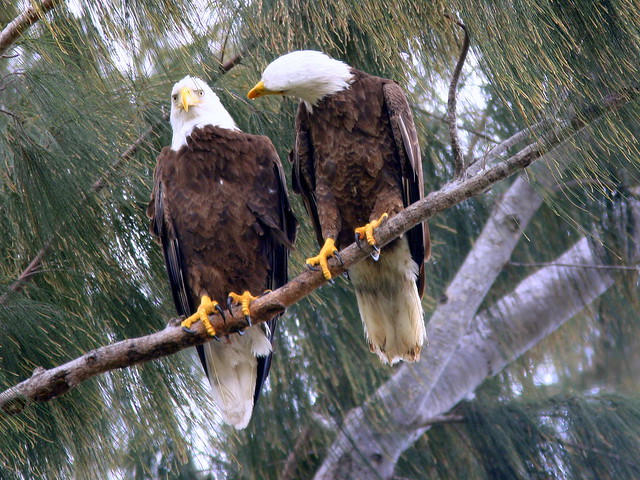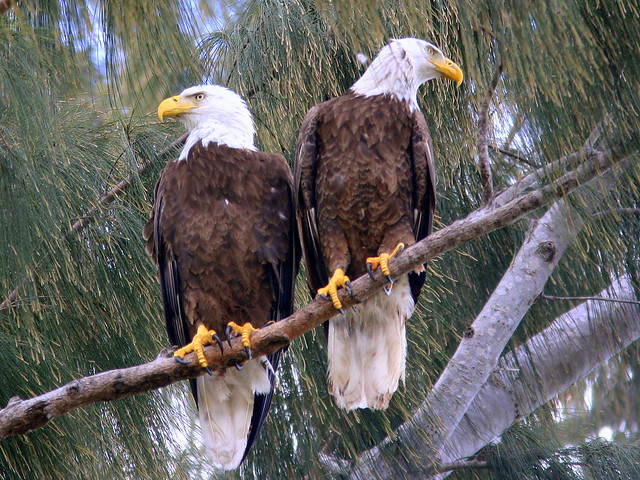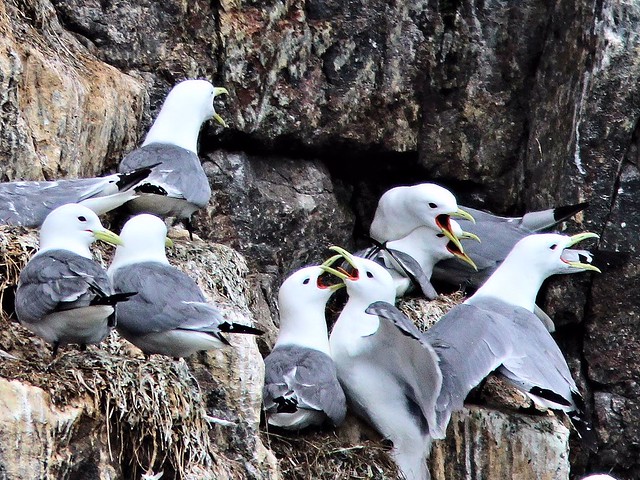Posted by: Ken @ 7:09 am
Just before departing Florida for our second home in Illinois, we managed one final walk in our local wetlands patch. Warblers were still coming through, but not in great numbers. On some days Northern Parulas were common, but we saw only a few.
They all were brightly colored males. Their foraging habits are methodical, as they usually explore one limb at a time, starting at the base of a branch and working out to the very tip. They sometimes emerge into plain view before flying to the next branch, providing photo opportunities.
Prairie Warblers are seen here all year, but their numbers are swollen during migration and winter by temporary visitors. They also tend to spend much time in a small area of a tree, but are not as predictable in their movements.
In quite the opposite fashion, the movements of American Redstarts are totally unpredictable. Many of my attempts to photograph them produce only empty branches. This sweet little female redstart paused just long enough for me to capture her beauty and energy.
This fall, Black-throated Blue Warblers have been favored subjects. The
males have strongly contrasting blue, black and white plumage. They often appeared in small same-species flocks.
I really liked the feather detail in this pose.
Warblers are attracted to fruiting shrubs, usually for the insects they attract, but both the parulas and this Black-throated Blue Warbler have a taste for privet berries.
Female Black-throated Blue Warblers do not resemble the males except for the white mark on each wing.
The face pattern of females is distinctive.
Two Yellow-throated Warblers showed up on our final walk. This was only the second time I had seen this species in our patch.
Common Yellowthroats were, well, common! Usually shy and retiring, their movements are difficult to track as they creep through the low shrubs and tall grasses. The fruiting privet (Ligustrum sp.) lured them into the open, but they seemed interested only in the associated numerous spiders and other insects.
The female yellowthroat lacks the black mask of the male.
Palm Warblers have arrived and will be here all winter. Our local visitors belong to the drab western subspecies. Interestingly, their migratory path crosses that of the more colorful eastern population, which winters in Texas and Mexico.
The Palm Warbler’s long legs are an adaptation to its habit of foraging on the ground. Early morning light enhanced the color of this one.
Another long-legged warbler, the Ovenbird, walked up almost to my feet before I saw it.
We departed Florida before seeing our first Yellow-rumped Warbler, the avian equivalent of the “fat lady” who sings at the end of the opera. Migration is not over until the “butterbuts” appear. We did catch this one the first morning after we arrived in NE Illinois, at local Nelson Lake. Sure enough, it was the only warbler we encountered there.
Of course, we saw many other interesting birds besides warblers during our final week in Florida. A Bell’s Vireo showed up once before, in October of 2009. Although it is a western species, it is a rare but fairly regular visitor to South Florida during spring and fall migrations
A pair of Common Ground-Doves posed in the early morning sun.
Blue Jays collected Live Oak acorns from the bumper crop.
Blue-gray Gnatcatchers can be a pesky distraction when we confuse them with the warblers as they they flit among the branches. However, they also seem to be “magnets” for other migrants, perhaps alerting them to food sources.
Bald Eagles regularly pass overhead just after sunrise, traveling from their nest area two miles to the north, to hunt for fish and water birds in the large lake in our subdivision. They are out earlier on clear mornings, probably because of better visibility.
The songbirds fell silent as a Cooper’s Hawk flew overhead.
A single adult Wood Stork has visited our backyard lake several times during the past month. As if to bid us adieu on the morning of our last day in Florida, a flock of six flew in while it was still dark. I had to wait to take these shots. By then only one remained on our back lawn and the others had flown to the other side of the lake.
Posted by: Ken @ 11:48 am
We are still in the grip of summer-like weather, with heat, humidity and rain almost every day. We normally would be entering the mild dry season when we can leave the windows open all day and night. Near freezing low temperatures in northern Illinois will be a shock for us when we return there in a few days.
Atmospheric conditions have created photographic challenges but also opportunities. Although rain shortened several of our treks into the wetlands near our home, we have also enjoyed some fabulous pink sunrises.
This photo was taken about 10 minutes before sunrise, four days ago, looking south down the unpaved road that leads into our birding patch.
Almost every summer, tropical winds carry dust particles 5,800 miles across the ocean from northern Africa. The dust is able to cross that distance because it travels in the Saharan Air Layers, on top of a lower cooler layer of atmosphere, according to the National Aeronautics and Space Administration. Hurricanes follow the same path from the African coast, but the dust can produce some beautiful pink sunrises in south Florida. This, along with high humidity, may well have been the cause of the pink color of the sun’s rays.
Here is a screenshot that shows the density of dust in the Saharan Air Layer on October 20. Fairly high dust levels are present near the tip of the Florida peninsula, just visible in the upper left hand corner of the image.
See the latest satellite images of the Saharan Air Layer at this link.
A Great Egret balanced on the very top of an Australian Pine, and the high pink clouds provided a pleasing background.
The egret took flight.
The skies quickly turned from pink to black as thunder rolled. Wisely, Mary Lou had departed well before me. Here is the road ahead as I hurried back home, just beating the rain.
The next morning I photographed what I erroneously called a “false sunrise” on the western horizon over the Everglades, at 7:22 AM, EDT. This view is directly opposite the spot where the sun was scheduled to appear above the horizon in about 2 minutes. The sky overhead was clear and already quite blue, but the scattered high clouds were pinkish. There were thunderstorms over the Atlantic coast, so it was quite dark to the east. The rays of the sun had filtered over the tops of the thunderheads and painted long parallel pink streaks. Perspective gives them the appearance of diverging from the west, but they actually are converging from the east towards the vanishing point. Perhaps the best term for this would be a “mirrored sunrise.” (* See end note)
Interestingly, another Great Egret posed in a different tree, about three minutes before sunrise. The pink in the sky was not as intense as on the previous morning. The photo is soft because I had to crank the ISO up to 6400 to get a 1/2400 second exposure without using my flash.
A Northern Waterthrush suddenly appeared in the semi-darkness, and the flash was necessary for a decent exposure.
The radar has shown quite heavy migration this week. I think they were mostly catbirds, as the trees were full of them. Lighting had improved a bit when I took this photo of a Gray Catbird a few minutes later, without flash (ISO 6400, exposure 1/320).
Brown Thrashers are passing through on their way south. A few breed in south Florida.
Here are some other images from the past week, under somewhat better lighting conditions. First, a male Painted Bunting, locally common during the winter, …
…and a female bunting dressed in green.
I often see Indigo Buntings in the company of Painted Buntings. This is a female– note her streaked breast.
The male Indigo Bunting shows some blue on its flight feathers and wing coverts, and is not heavily streaked.
Northern Cardinals are in fine feather, having just completed the post-breeding molt.
Noisy and inquisitive Blue Jays also show fresh plumage. Resident jays are now joined by migrants.
Northern Mockingbirds are singing and defending their territories.
A migrating Ruby-throated Hummingbird comes in for a landing…
…and settles down.
This is a migratory first year male Rose-breasted Grosbeak.
* I searched the Internet for any other descriptions of this phenomenon, which looks like a mirrored sunrise on the opposite horizon, but did not find much information. I learned that my terminology is not correct. Technically, a “false sunrise” or dawn sundog is… an atmospheric optical phenomenon associated with the reflection or refraction of sunlight by small ice crystals making up cirrus or cirrostratus clouds in the very particular case when the sun is still below the horizon. Ref: http://en.wikipedia.org/wiki/False_sunrise
Here is a similar photo of a mirrored sunrise over Katy, Texas in FLICKR: http://www.flickr.com/photos/brettmorrison/8095394320/in/pool-texan/
I did find a You Tube featuring another mirrored sunrise here: http://www.youtube.com/watch?v=Rr7gASBeQBE
Posted by: Ken @ 4:37 am
With a couple of other birders from South Florida Audubon, I visited Corkscrew Swamp east of Naples. This Audubon sanctuary is a marvelous place. If you can read the sign below, it shows the habitat features traversed by more than two miles of boardwalk trails.
Since fall migration is in progress, we rather expected to be treated to many warblers. For some reason this did not happen. There were several warblers, but all were high in the trees, deep in the shadows, or back-lighted by the sky. It was an enjoyable trip, despite the heat and humidity.
Entrance sign (click image to enlarge).
This section of the boardwalk meanders through a Pond Cypress stand.
The Pond Cypress swamp looked promising, but we found relatively few birds.
A Pileated Woodpecker foraged near the entrance. Good views of this species are almost guaranteed on any visit to Corkscrew Swamp.
Great Crested Flycatchers were numerous.
Tufted Titmouse were calling everywhere.
A Carolina Wren was going the other way, but this was the best I could do.
A light morph Short-tailed Hawk flew over, but it was impossible to get a photo through the intervening branches. This Red-shouldered Hawk, seen from the viewing platform in the open Central Marsh area was more cooperative.
Because of the high water that disperses aquatic prey, waders were few and far between. This Little Blue Heron is the only heron we saw within the preserve, though many were out in nearby retention ponds.
A Green Tree Frog clung to a plant stem.
I believe this is a Florida Red-bellied Turtle, but I welcome confirmation of the species.
A Swamp Lily almost seems to glow in the shade of the cypress trees.
A highlight of the walk was seeing two rare orchid species in bloom.
The Clamshell Orchid is quite rare in the Everglades, as it has very demanding habitat requirements. Florida can have cold snaps, and the water in Corkscrew Swamp holds onto the heat and protects tender vegetation. However, this orchid ranges in the tropics from Mexico to Brazil and is common in many orchid collections.
The Ghost Orchid is so called because it lacks leaves, yet from some angles its flower resembles Casper the Ghost. The plant consists only of a spider-like root system that clings to the bark of trees, and flowers that boom infrequently. It grows only under very hot conditions. It is very rare in the wild, and only two specimens are visible from the boardwalk at Corkscrew Swamp.
The second Ghost Orchid had just finished blooming only two days previously. Here is its root system and the dried-up remains of a single flower. The orchid is not a parasite, but an epiphyte that dwells on the tree and derives no nourishment from its host.
Despite the lack of birds, we found many other photographic subjects, including this poisonous White-marked Tussock Moth. Its hairs can cause a nasty painful rash.
I could not identify the species of this orb weaver, but it has rather distinctive dorsal abdominal markings.
Posted by: Ken @ 1:00 pm
It was about 15 minutes after sunrise and cloudy when Mary Lou and I approached the bend in the road at the junction of the unpaved portions of Miramar Parkway and SW 196th Avenue. I had pre-set the ISO at 800 (aperture open all the way to f/5.6) but did not expect to take any photos until after we completed the fast-paced “aerobic” mile into the wetlands adjacent to our subdivision. Only about a quarter mile into our walk, we suddenly saw a Bobcat standing almost in the middle of the road, about 100 yards away.
This was the first time one had posed out in the open roadway like that. We slowly moved up to about 50 yards before the cat fled. Unfortunately, I had kept the camera in an air conditioned room, and the lens fogged up pretty badly in the stifling heat and humidity. I wiped them a few times, but the quality of all the photos suffered.
This was about the sharpest image I got, so I processed it a couple of different ways. The above one is made up of four layers on the cropped original RAW image, each with a different exposure compensation (-1.0, -0.5, +0.5 and +1.0), thus producing an HDR-like effect. The cat suddenly fled towards the levee path that follows south along the 196th Avenue Canal.
I followed the Bobcat’s retreat route up along the levee path, but never caught sight of it again. However, I found very fresh Bobcat scat. The Bobcat dropped these feces out in the open with no attempt to conceal them, suggesting it was a male. Females usually deposit it less conspicuously and often scratch dirt over it as do House Cats. Note heavy black “tar” color due to digested blood, characteristic “Tootsie Roll” segmentation, large bore (~1 inch), inclusion of much hair and few bone fragments.
Three female White-tailed Deer appeared up ahead and walked towards me. I stood motionless , but the sun was getting higher and I became uncomfortably hot and finally started to move into a shady area. This frightened the does. It is a treat to see them here, as they are not very abundant.
I gave up my attempt to stalk the Bobcat and checked out the birds. A Loggerhead Shrike looked down at me from the top of a shrub.
Moving back down the what is left of my “Fake Hammock,” I took a spot in the shade and waited to see which birds might show up. This Northern Mockingbird was one of several moving about.
Predictably, a Prairie Warbler came out of hiding.
An Ovenbird peered out from the deep foliage.
Several Brown Thrashers have congregated in this area, more often heard than seen. This one flew out into the open.
A pair of Common Yellowthroats busily foraged in the low vegetation. The male briefly came out into the light.
Palm Warblers have arrived in good numbers. All are of the somber Western subspecies. Oddly, the east coast birds turn to the southwest before reaching Florida and the Gulf of Mexico, on their way to spend the winter in Texas and Mexico. Their paths cross with the western population, which flies SE to winter in Florida and Cuba. They reverse the criss-cross pattern when returning north in spring.
Suddenly a Northern Waterthrush walked out of the darkness unto a small limb, its tail slowly bobbing characteristically.
The waterthrush paused to look me over before flying off.
A Bald Eagle flew over, tracking a perfect line from its nesting area two miles northwest in Pembroke Pines to the large lake in our subdivision. For updates on our local eagle nest, visit my Bald Eagle Nest Watch FORUM.
On the way home, I saw several White-winged Doves lined up on a neighbor’s roof.
Posted by: Ken @ 2:31 pm
I can’t remember when I started “playing” the piano, but by the age of 5 or 6 I could perform many simple songs, provided they were on the white keys. Within a couple of years I taught myself to accompany the melodies with “um-pah” chords with my left hand. Hit the root note with my pinkie, and go up one octave with my index finger; add the third note above and the fourth below. Make “sad” chords by moving my thumb down one half note, switch the chords to fit the sound of the melody. All of this without knowing the names of chords, whether major, minor, sevenths, ninth, diminished, or augmented. Only much later in life did I learn something about music theory. The theory helped me understand the rules, and made it easier for me to apply their principles and advance in knowledge.
Likewise, I’ve been watching birds most of my life. I know many of their sounds and behaviors, but I never fit them into any kind of system or theory. Jon Young, in his little book What the Robin Knows: How Birds Reveal the Secrets of the Natural World (Houghton Mifflin Harcourt), has enriched my birding experience by providing such a framework. It’s not a rigid system or code, but it helps interpret the actions of birds.
We’ve all had days when birding was slow. The time of year is right, the habitat looks perfect, but the birds seem to have disappeared. We might hear a familiar bird calling or singing here or there, but none are in view. We turn to watching butterflies and dragonflies, or simply end up saying it wasn’t a “birdy” day and return home disappointed.
An endorsement on the dust cover of Young’s book states “…[A]fter reading his marvelous book…[y]ou’ll discover a universal bird language that will speak to you whenever you go outdoors.”
Don’t you ever wish you could understand the language of birds? I’ve talked to the birds, and they’ve talked back to me and then to each other (Much ado about a squeak). Once, their excited scolding helped me trace the movements of a Bobcat as it circled around behind my back in the wetlands, and their silence has alerted me to the presence of predators overhead.
My iPod has an app which can translate speech into any of several selected languages. Since I have Cuban in-laws with extended families, I have used it to communicate with some of the non-English speaking relatives. Sometimes what comes out bears little resemblance to the intent of our words. We end up laughing into the speakers. Laughter, facial expression and other non-verbal clues often reveal more than our words.
This book won’t provide a literal translation of the robin’s calls and songs. It goes beyond the individual sounds, and provides them in a behavioral context. Much attention is devoted to the “body language” of birds when they are subjected to various types of disturbance. Their responses are described in three dimensions (and in a fourth dimension, time), supplemented by instructive diagrams. Young calls them the twelve “alarm shapes.”
What were these Gray Catbirds saying to each other? Are they fighting, or are they courting? Actually, their calls did not sound angry, and their pursuit seemed gentle, so I assume it was the latter.
These two Northern Mockingbirds were issuing more hostile calls.
This pair appeared to be squabbling over their property lines.
The mockingbird on the left was unwilling to give ground, and the hostility escalated, evidenced by their body language and slurred calls.
They finally came to blows. If my iPod were able to translate their “words,” there would probably be many bleeps in my transcript of this confrontation. The bird to the right flew off. My guess is that it was the intruder.
Birds cannot smile or grimace. The bony ridge over the eyes of eagles produces a perpetual frown. The male Bald Eagle, on the right, was acting amorous. Was he whispering “sweet nothings” into his mate’s ear?
He is startled when she rebuffs him severely.
Now they are obviously not on speaking terms.
Wild creatures don’t waste precious energy, so their actions are usually purposeful. What were these Black-legged Kittiwakes trying to accomplish with their raucous clamoring?
The first few chapters of What the Robin Knows classify and describe five basic types of bird vocalizations. Young calls the first four “baseline:” songs, companion calls, territorial aggression, and adolescent begging. These are the sounds associated with the birds’ normal activities. Disturbances and threats that upset this state of equilibrium stimulate birds to issue various types of alarm calls, the fifth category.
The text of the book provides examples of calls and songs by referring the reader to a collection of audio files at the author’s website, BirdLanguage.com. At first I found it a bit cumbersome to interrupt my reading to access the desktop computer. I tried listening with the browser on my iPod, but the files were in an incompatible format, possibly Adobe Flash. I even put off reading the book until I could use my netbook which I had left back in Illinois. Ultimately I found it easiest just to listen the the entire set of sounds in one sitting. Many were already familiar, but the experience helped me to understand their classification in the author’s scheme. Doing it this way also demonstrated some inter-species similarities between the various types of calls. Contact calls generally sounded soft and peaceful, while alarm calls were emphatic and energetic.
In late summer I took my usual morning walk in the wetlands next to our south Florida home. Although the sun was just rising, I was not greeted with a chorus of bird song. A couple of Eastern Towhees could be heard singing their “tip-tip-tee-tee-tee-tee-tee” song. A Common Ground-Dove produced an intermittent coo-like low whistle, a few mockingbirds sang halfheartedly, and a Carolina Wren burst into song and then fell strangely silent. Common Grackles fed their begging offspring. It was a perfect morning to pay attention to the birds’ baseline sounds.
Back in Illinois in the fall for warbler migration, I birded my favorite patches and had the familiar experience of having some great days with lots of sightings and other days when I was greeted by an eerie silence. But, thanks to this book, I made a special point of listening to the silence. Baseline sounds that I previously ignored took on new importance. I recognized the little two-note begging calls of fledgling goldfinches, the soft “seep!” contact calls of robins, and the quiet “chips” of a pair of cardinals.
While sitting in our daughter’s back yard I saw a good example of one such “shape.” I was watching chickadees, Mourning Doves and House Finches at and around her feeder. Suddenly the birds on the ground flew up into the trees. Some selected perches nearby, but all perched at least 5 feet off the ground. I knew that this was not the “shape” of an alarm triggered by a bird-seeking raptor such as an accipiter or falcon. At first I did not see the threat, but in a minute or so a neighbor’s dog ambled along their back fence line.
I think back to the time when I was photographing a Savannah Sparrow in the same back yard. It was exposed out in the open on a fence rail. Suddenly the bird looked up and froze in place. I also glanced up to see a Red-tailed Hawk moving along at rather high altitude. The sparrow appeared to recognize that the hawk posed no immediate threat, but took the precaution of stopping all motion so as not to attract undue attention. Contrast this to the time when a Sharp-shinned Hawk suddenly swooped into the yard, and the birds dove for the nearest cover.
Jon Young draws upon not only his years of experience learning and teaching the language of birds, but also that of others, including professional trackers and indigenous elders, dwellers of bush and jungle. When you read this book, I suggest that you get out in the field after reading each chapter and allow what you have learned to enrich your birding experience.














